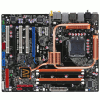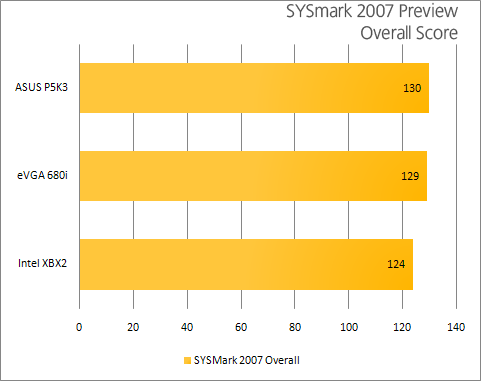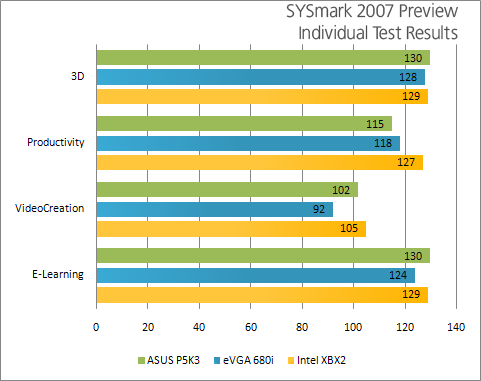- Qualcomm Launches Snapdragon 4 Gen 2 Mobile Platform
- AMD Launches Ryzen PRO 7000 Series Mobile & Desktop Platform
- Intel Launches Sleek Single-Slot Arc Pro A60 Workstation Graphics Card
- NVIDIA Announces Latest Ada Lovelace Additions: GeForce RTX 4060 Ti & RTX 4060
- Maxon Redshift With AMD Radeon GPU Rendering Support Now Available
ASUS P5K3 Deluxe WiFi-AP

Intel’s P35 chipset was only just released, but ASUS already has seven motherboards which utilize it. We are taking a look at one of their top models, the P5K3 Deluxe. This board utilizes DDR3 memory and has WiFi capabilities built-in. It also turns out to be a great overclocker.
Page 3 – Testing Methodology, SYSmark 2007
|
|
Throughout all of our benchmarks regardless of what we are reviewing, testing is done in a clean and stand-alone version of Windows XP Professional with SP2. No Windows Updates are applied for the sake of efficiency, unless one is required for a piece of hardware on the computer. Prior to testing, these conditions are met:
- Desktop and scrap files are cleaned up, including emptying of recycle bin.
- No virus scanner or firewall is installed in the stand-alone installation.
- The stand-alone installation drive is completely defragged using Diskeeper 2007 Professional.
- All unnecessary programs are closed, so that Windows should have no more than 15 active processes running.
- Computer has proper airflow.
The testing rig used for todays benchmarking is as follows:
- CPU: Intel E6600 – 2.4GHz
- Motherboard: ASUS P5K3 Deluxe WiFi-AP
- Memory: Kingston 2GB HyperX PC3-11000 (For DDR3 Board)
OCZ 2GB NVIDIA PC2-7200 (For DDR2 Boards) - Video: ASUS EN8800GTX 768MB
- Sound: Onboard HD Audio
- Storage: Seagate 7200.9 320GB
- Etcetera: Windows XP Professional 64-Bit
- Cooling: Corsair Nautilus 500
-
Compared Motherboards
- eVGA 680i (P27 BIOS)
- Intel XBX2
The ASUS P5K3 is the first DDR3 board we have used, therefore we will not have any comparisons to other P35 boards in this article. You can expect near-future comparisons, however. Here are the memory speeds used on each platform:
- DDR2 memory is run at DDR2-800 speeds with 4-4-4-12-2T timings at 1.9v
- DDR3 memory is run at DDR3-1066 speeds with 6-6-6-15-2T timings at 1.6v
It’s important to note that the DDR3 is running faster, although with lower timings. Both settings listed above is what we consider standard for each platform. Not many will purchase DDR3 memory to run at DDR3-800. DDR3-1066 at 6-6-6 proved to be our sweet spot given the voltage. We didn’t want to lower into the 7-7-7 territory, and we believe most good DDR3 kits will handle those speeds/timing set well.
SYSmark is an industry leading system benchmarking tool, which is completely automated but utilizes real-world tests. It installs common applications such as Microsoft Word and Excel, Photoshop CS2, 3DS Max, SketchUp! among others.
SYSmark grades the performance of the system with various methods, but most notably how well it could handle different operations. Systems with more than one core will benefit in the tests, since there is a lot of multi-tasking throughout. Once the test is completed, it will provide you with an overall score, in addition to showing areas where the computer excelled.
Taking a look at the overall graph, we can see that the P5K3 performed exceptionally, though the eVGA came quite close to matching its score. The XBX2 fell quite a bit behind.

The individual test results can give us a deeper look at where each board failed, or performed well. Regarding 3D tests, all of the motherboards performed quite well to one another. When performing personal renders with 3DS Max, I found that this was always the case. Throughout the three different boards, not one had an advantage.

Although the XBX2 had a lower overall score, it blew past the other two boards in the productivity set. In fact, it performed better than both of the other boards in the VideoCreation test as well, and matched up well with the P5K3 in the E-Learning. Why its overall score showed the opposite, I have no idea. The P5K3 performed well throughout all tests though, although even with its faster memory, it did not walk away a clear winner.
|
|
Support our efforts! With ad revenue at an all-time low for written websites, we're relying more than ever on reader support to help us continue putting so much effort into this type of content. You can support us by becoming a Patron, or by using our Amazon shopping affiliate links listed through our articles. Thanks for your support!





